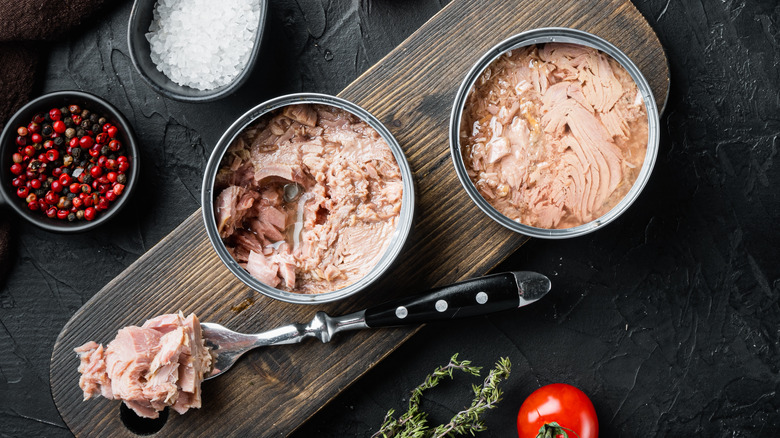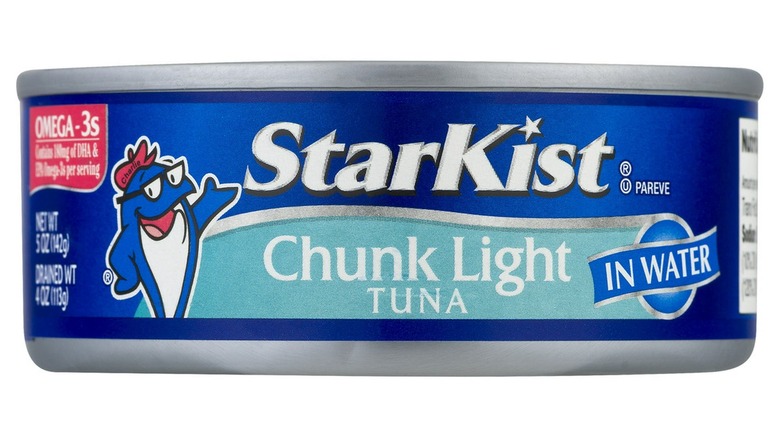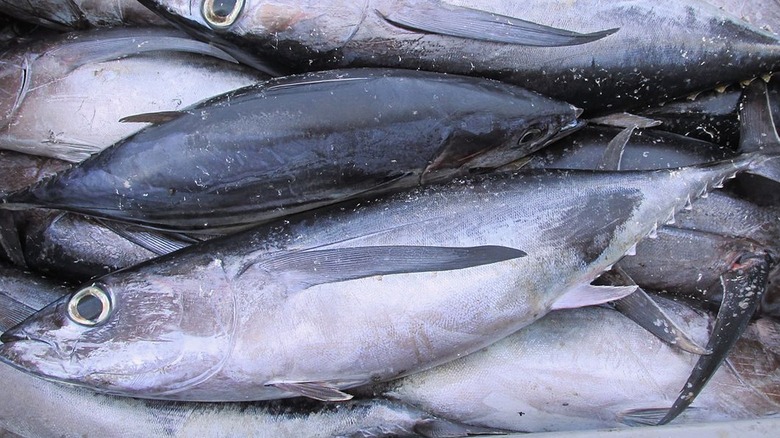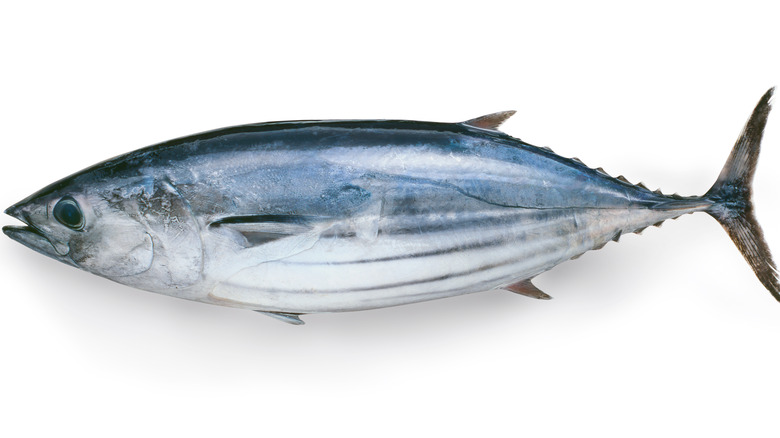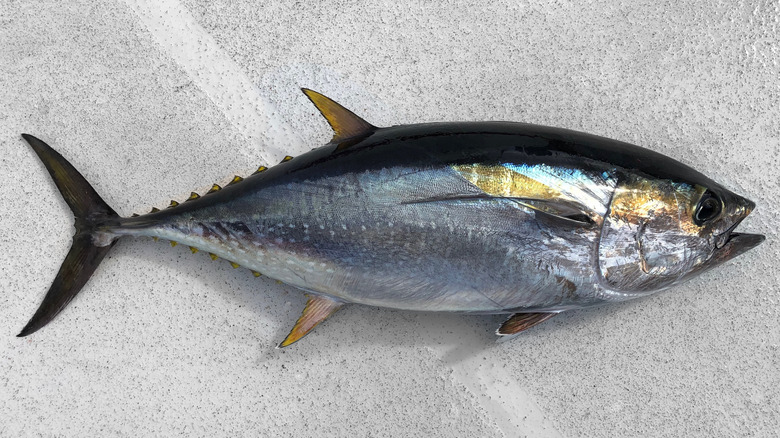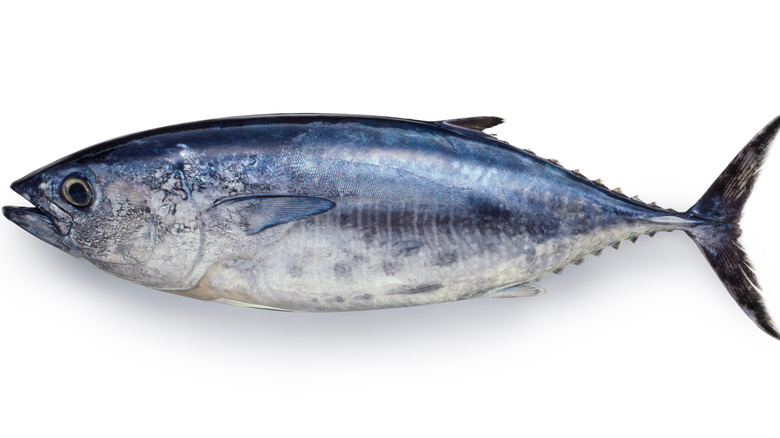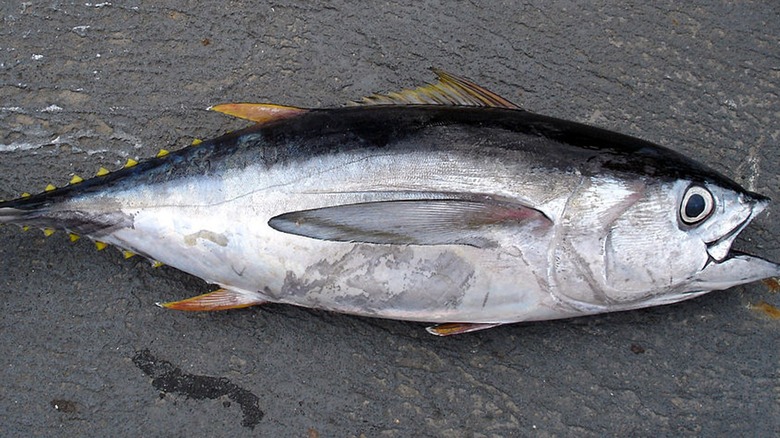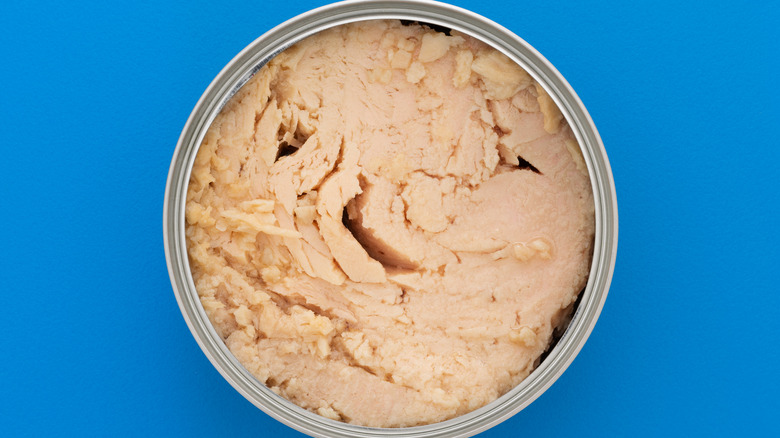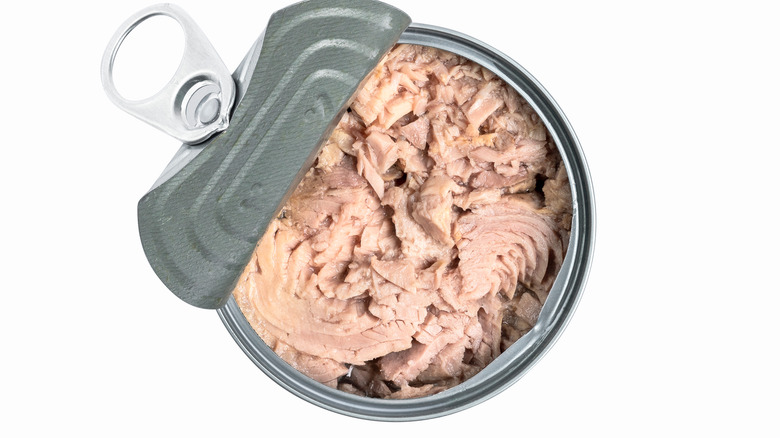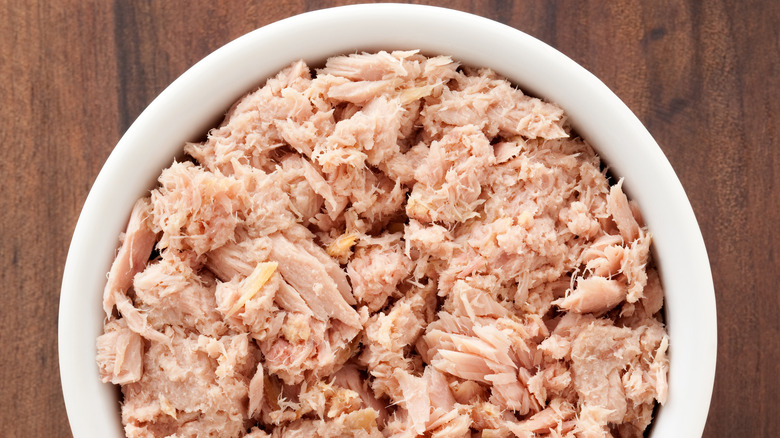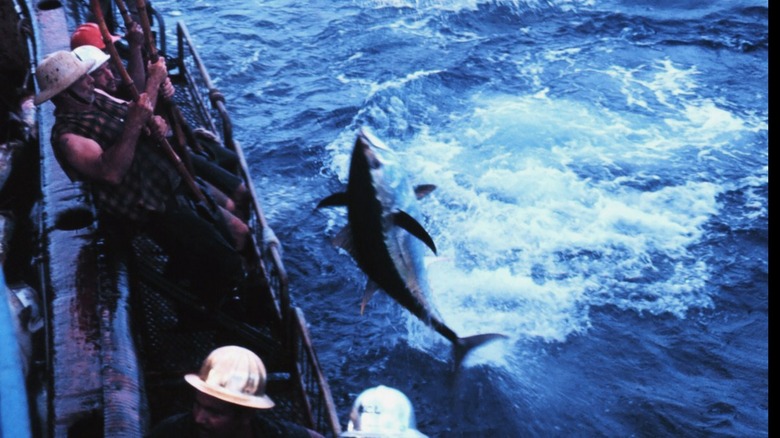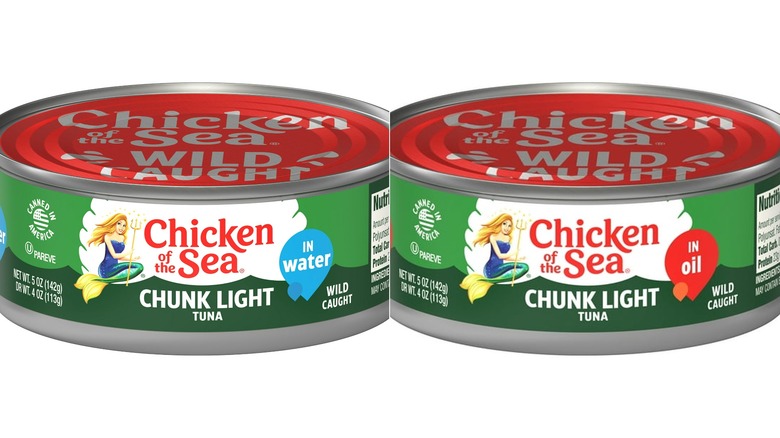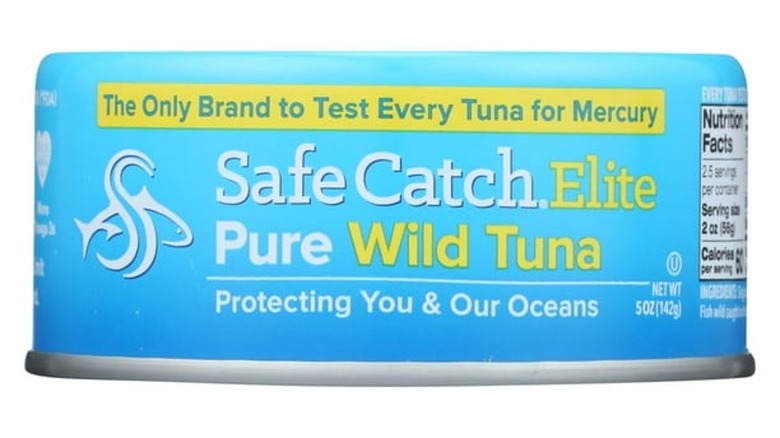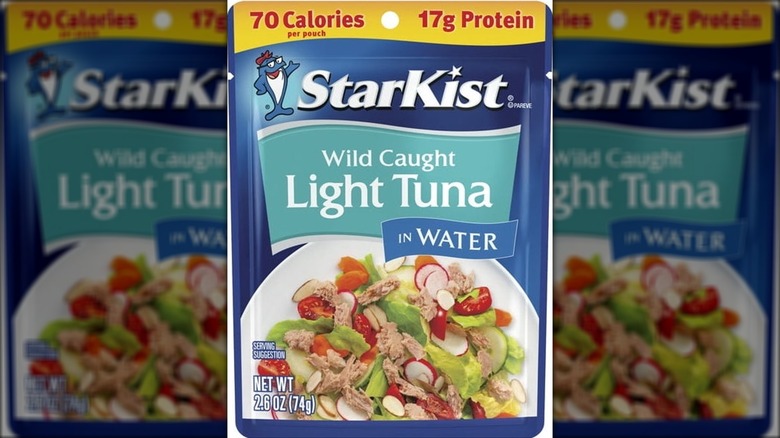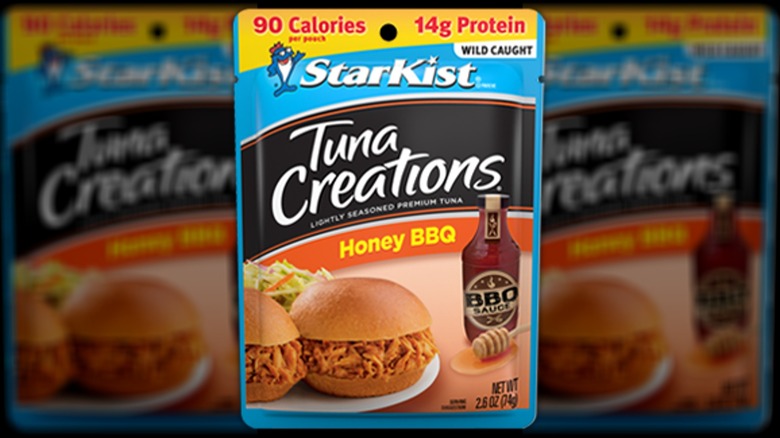The Differences Between Canned Tuna Explained
Have you ever stared at a sea of canned tuna trying to figure out which one you should buy? We certainly have. Even if you get a variety you don't like, it can be challenging to know what made it an unpleasant experience if you don't understand the lingo. If you're a tuna lover, it's high time you learned about all the different varieties, flavors, and textures as well as ways they're raised and caught. Understanding more about what's on the package can help you know what to buy and what to avoid next time you're standing in the canned fish aisle at the grocery store.
If you're a typical American, you're likely eating 1.9 pounds of this canned fish each year, according to 2021 per capita consumption from the National Fisheries Institute, so it makes sense that you should be able to decipher the label to get the type that will suit your tastes best. So, let's do a deep dive into tuna lingo and species to help you understand exactly what you're looking at in the tuna aisle and exactly what you're putting into your shopping cart.
Light tuna
Light tuna is the most popular type, accounting for 75% to 85% of the sales in the U.S. each year. The most popular type is chunk light tuna, which is canned with water rather than oil. "Light" generally describes the kind of fish so you know what color and nutritional values you're getting but not necessarily what species.
When you open up a can labeled "light," you will notice that the fish is pink or tan, not white. Light tuna is usually yellowfin (Thunnus albacares) or skipjack (Katsuwonus pelamis). Both species are soft and have a richer, fishier flavor than the white type. The light type also has slightly less fat and fewer calories than white tuna, making it a somewhat nutritionally "lighter" choice. However, it also contains less omega-3 fatty acids than white tuna.
Another reason the light variety is popular is because of its potentially lower mercury content. The Food and Drug Administration lists the light type among the best choices when it comes to consuming fish most likely to be low in mercury. In fact, the FDA suggests eating two to three servings per week since it's not a big mercury risk.
Albacore tuna (white tuna)
Unlike light tuna, white tuna is actually a fish species – albacore tuna (Thunnus alalunga). About 20%-25% of the canned tuna that consumers buy in the U.S. is albacore. These fish live in deep ocean water and account for only about 5% of the tuna types caught around the world.
When you open a can of albacore, you'll realize that "white" describes the flesh. Rather than being pink or tan, the flesh is closer to white. Albacore also has a milder, less fishy taste than the light variety. Thus, it's often called the "chicken of the sea." While it's slightly higher in calories and fat than the light variety, albacore tuna has more omega-3s, which can also make it more desirable. While the FDA doesn't consider it among the best fish choices to avoid mercury, it's still listed among the good choices. However, the FDA advises only one 4-ounce serving per week of albacore since it carries a mercury risk.
[Featured image by Joachim Langeneck via Wikimedia Commons | CC BY-SA 4.0]
Skipjack tuna
Skipjack tuna is one of the two types of fish you're likely to find in a can of light tuna. In fact, you're more likely to find skipjack labeled "light" than yellowfin because it is the most-caught of any species in the world, accounting for 58% to 60% of all fish harvested. Despite being easy to catch, the International Union for Conservation of Nature (IUCN) lists them as a species of least concern for extinction. These fish live in warm and tropical ocean waters (never getting colder than 59 degrees Fahrenheit), and they're also the smallest type.
Since they're a light variety, they have a fishier and richer flavor than some other types. So, you may want to consider the strong flavor profile when deciding whether to add it to your next tuna dish or opt for another variety. The FDA lists skipjack as among the best choices for fish with a low level of mercury. As such, you're welcome to eat two to three servings per week if you would like.
Yellowfin tuna
If your light variety of fish isn't skipjack, it's yellowfin tuna. It only accounts for 29% of the tuna caught, so it has a smaller chance of being in a can of the light variety than skipjack does. The species migrates among several oceans and tends to spend time with dolphins, so you'll especially want to look for dolphin-safe tuna if you know you're getting a can of yellowfin.
If you choose yellowfin, you will end up with a stronger, fishier-tasting fish than albacore. So, like skipjack, you'll want to use it in dishes where fishy fish is fine. The non-canned variety is the most popular type of fish you'll find in sushi in Japan. As a light variety, yellowfin is on the FDA's list of the best fish choices for avoiding mercury. So, you can go ahead and enjoy two to three servings of it every week without concern.
Bluefin tuna (ventresca)
Bluefin tuna is more expensive than a lot of other types because only 1% of the tuna harvested belong to this species. A 610-pound bluefin sold for $3 million in Japan in 2019 (about $307 an ounce). Luckily, canned bluefish prices start at about $10 for a 4-ounce tin. However, they only go up in price from there. Most luxury tinned bluefin you will find is labeled "ventresca," which is the Italian name for it. Unfortunately, Southern bluefin is on the IUCN's endangered species list. However, the Atlantic bluefin (Thunnus thynnus) is a species that is of least concern for becoming extinct, which is good news for bluefin lovers.
Other than being a rarer species, bluefin is sought after for its high fat content, which makes the meat tender, buttery, and nearly as spreadable as butter. It also lacks a fishy flavor, similar to albacore.
Despite the amazing texture and flavor, you probably shouldn't be eating bluefin very often, if at all. Experiencing bluefin comes at a cost since it's among the fish with the highest mercury content. The reason is that the fish being caught tend to be older and have acquired more mercury in their bodies with age. According to the FDA, high mercury levels can be harmful to anyone. It affects the brains of infants and children more intensely, which means children and those who are pregnant or breastfeeding shouldn't eat bluefin.
Bigeye tuna
Bigeye tuna (Thunnus obesus) gets its name from its large, cartoon-sized eyes. You're not likely to find a can of bigeye on store shelves because it's on the naughty list for having among the highest mercury levels. However, some brands may combine it with yellowfin and skipjack in their "light" selections, probably because these species tend to hang out together and get caught with skipjack and yellowfin when they're younger. The flavor is meaty rather than fishy like yellowfin and skipjack, and it's on the fatty side.
One reason you should avoid buying bigeye to eat is that it has been overfished. Thus, IUCN lists it as being vulnerable to eventually becoming extinct. The current population appears to be decreasing. However, a plan is in place to help manage harvesting them more sustainably.
The fact that the FDA lists bigeye tuna among the fish with the highest mercury levels is concerning. So, if you're buying the light variety, and the can doesn't specifically list the fish species inside, you might want to rethink your purchase.
Solid tuna
If you like canned fish that comes intact without a lot of small pieces, you're looking for solid tuna. When you open up a can of solid tuna, you'll see a lot of unbroken fish fillets packed in there. So, this is the type you might want to get if you're eating it by itself and not making it into a salad or casserole where you need pieces broken up. It's like the steak of tuna rather than stew meat or ground beef.
Solid meat tends to come from larger fish since the cooking process makes the fish more likely to fall apart before canning. Skipjacks are about 70 pounds, albacores average 125 pounds, yellowfins weigh around 400 pounds, and Atlantic bluefins can get as big as 2,000 pounds. So, it's easier to find cans of solid meat from larger fish like bluefin and yellowfin than from smaller fish like skipjack. You won't find solid light tuna in brands that mix species. However, the solid light variety does exist.
Solid fish tends to be a bit drier because it doesn't have as much exposed surface area to come in contact with the oil or water in the can. So, you might want to combine this fish with some sort of sauce when eating it alone to add moisture.
Chunk tuna
Chunk tuna is a type that is already broken into pieces but usually isn't mushy. When you're looking for canned fish to add to your favorite salad or casserole, you may want chunk instead of solid tuna. Since it's already broken down into small pieces, you likely won't have to do much work to get it ready for your recipe. However, we've noticed that some brands that list the texture as "chunk" have flaked meat inside, so the size and texture aren't an exact science. Typical chunk meat is more like pieces of stew meat than a steak.
Chunk fish either breaks into pieces on its own during the cooking process or gets broken into pieces purposefully during the manufacturing process. Chunk-style meat can come from any type of fish since their size doesn't matter. If you buy chunk light meat (the most popular tuna variety in the U.S.), you may be getting one type of fish or a combination of two or three.
Chunk fish is also more moist than solid fish because it has more surface area exposed to the liquid in the can. So, it won't need as much added moisture once you remove it from the can to make it palatable.
Flaked tuna
When you want even smaller pieces of meat compared with solid pieces or chunks, you'll likely want flaked tuna. It has a mushier texture, which works great in tuna salad, tuna casseroles, and other recipes where there's a smoother, more homogenous meat consistency. When you add ingredients like mayo to flaked meat, we've found that it blends together with a paste-like texture that isn't possible with solid or chunk meat without extra processing on your part. You could compare it to the texture of ground beef rather than steak or stew meat.
Flaked fish are the leftover pieces that fall apart during cooking and processing. Since this happens no matter the size of the fish, you're likely to find flaked fish from any species. If it's light meat, it may be a combination of multiple types of fish unless the species is listed on the package.
With a maximum amount of surface area exposed, the liquid in the can is able to truly permeate the meat. We've found that you may need to squeeze the meat a bit to drain the excess moisture for some recipes.
Pole-and-line-caught tuna
Tuna lovers who are concerned with sustainability will want to look for pole-and-line-caught tuna. This method of catching fish is exactly what it sounds like. Rather than using a net to drag in every fish and other aquatic life in the area, fishers use traditional poles and lines with bait to target a certain species. If the wrong type of fish falls for the bait, the fisherman can simply throw the fish back into the water and try again. This smaller-scale, eco-friendly fishing method reduces the amount of sealife that dies before being tossed overboard for being the wrong type.
This traditional fishing method takes longer, so the can of fish that ends up at the store may be more expensive. However, there are a lot of plusses to this method. Catching fish with a pole and line prevents overfishing, allows fishermen to target species at less risk for extinction, helps keep other aquatic life safe, and cuts down on fishing-gear ocean pollution. And it provides a profitable livelihood for local fishermen. So, if you see a can of pole-and-line-caught fish, you'll want to consider choosing it over ones without the label. Keep in mind that just because the label says it's "dolphin-safe" doesn't mean that it's also sustainably caught.
Tuna packed in water versus oil
When making your canned fish decision, you have the option of tuna packed in oil or in water. Which one you choose comes down to your nutritional preferences, your personal tastes, and your recipe.
Oil-packed is a good choice if you plan to eat the fish plain or want added flavor and richness to your recipe. You might also consider it if you're looking for meat with more moisture since the fat from the oil will permeate the fish. Some people find fish packed in oil to have a stronger rather than diluted flavor. It's also a good choice if you're trying to avoid adding condiments like mayo with more calories and fat. However, you will want to pay attention to the type of oil included. Some cans will use heart-healthy oils like olive oil, while others might contain soybean oil.
Water-packed tuna is a good choice if you're wanting to use the meat in a recipe and don't want a texture or taste change due to the oil. Keep in mind that, once you remove the water from the meat, you may need to add something else to keep the meat moist, like mayo. The nutritional content is also different. For example, a typical can of chunk light packed in water might contain 50 calories and 0.5 grams of fat, while a typical can of chunk light packed in oil from the same brand contains 70 calories and five grams of fat.
Wild-caught tuna versus farm-raised tuna
As the monikers suggest, wild-caught tuna spend their lives swimming out in the wilds of the ocean, while farm-raised tuna spends their lives restricted to a dedicated fish farm. There's ultimately a difference in cost, nutrition, flavor, texture, color, and sustainability.
Farm-raised varieties represent only 1% of what's available in the world. They either live all their lives in a hatchery or are transferred from the ocean to a tuna ranch to fatten them up for eating. Since farm-raised fish live in a restricted area with a diet specially tailored so they gain weight, they tend to be fattier and have more protein. The meat is lighter colored, has less flavor, and tends to be fishier. They are also more likely to be contaminated with anti-algae chemicals. However, they will be cheaper because the farming process costs less than the process of catching fish in the wild.
Wild-caught varieties are the most widely available type, accounting for 99% of what the world eats. These fish have less fat because of their ability to swim wherever they want and eat whatever they find. Their eating habits also make them leaner and taste less fishy. Wild-caught fish are about twice as expensive because of the effort required to catch them. However, letting them live in the wild is more environmentally friendly. Their flavor and effect on the environment make wild-caught fish a better choice, so it's definitely something to consider when buying canned fish.
Pouch tuna versus canned tuna
Whether you should buy tuna in a pouch or in a can depends largely on personal preference, storage options, how long it might be on your shelf, and cost. However, the jury is out on taste, with some people preferring one, and some people preferring the other.
You won't find extra liquid added to pouches like you will in a can, so you don't have to bother draining it. However, it's drier, so you may end up needing to add more liquid or creamy ingredients as part of your recipe. While the piece of fish in a pouch may start out larger and more intact, the soft sides of the packaging make it more likely to end up in pieces. Pouches are also more versatile for storage than cans and fit into tighter spaces. They also tend to be more expensive.
If you like solid fish, you're likely to get a more intact piece of fish from a can than a pouch because the can has the ability to protect the meat from getting smooshed. If you don't go through fish super fast, you might want to choose canned fish instead of fish in a pouch. Canned varieties expire in four years, while pouched varieties will only last three years. Canned fish also tends to be cheaper.
Flavored tuna
In the past few years, it's become more common to find flavored tuna at the grocery store. You'll find most of these in pouches instead of cans. These containers of flavored fish are great for eating alone, eating on crackers or in sandwiches, or adding to recipes. However, if you plan to eat them plain and get them from a pouch, you might look for some that contain a little bit of oil since pouches have less liquid.
You'll find a wide range of flavors, including applewood smoke, bacon ranch, Thai chili, herb and garlic, and lemon pepper. So, you may want to give a few a try to find the one you like best. Some of our favorite tunas with added flavoring include StarKist Tuna Creations honey BBQ, all of the flavors from Freshé (Thai sriracha, Provence nicoise, Aztec ensalada, and Sicilian caponata), and lemon and thyme Chicken of the Sea Infusions.
